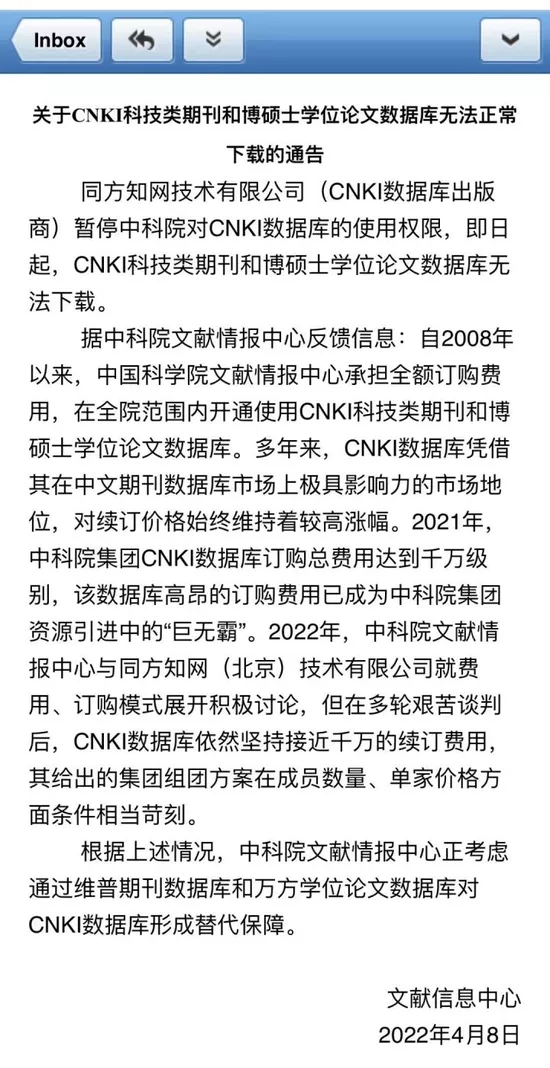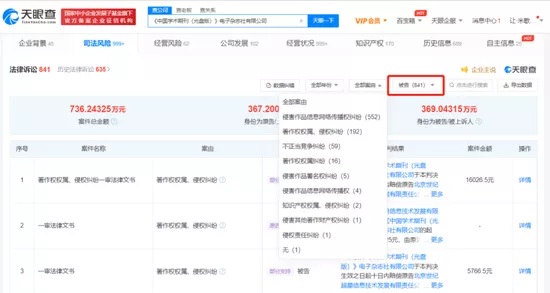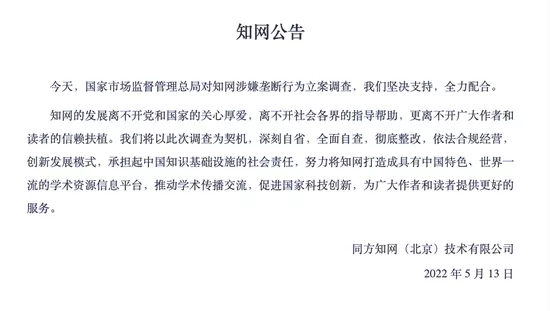Suspected of monopoly, HowNet checked! An academic platform founded for more than 20 years supports a listed company earning more than one billion a year. Behind the "no cost, no profit" business, surging public opinion such as "kidnapping consumption", "professors' rights protection" and "College deactivation" has been accumulating and fermenting. Finally, the General Administration of Market Supervision announced a heavy blow with 31 words. On May 13, according to the website of the State Administration of market supervision, "recently, the State Administration of market supervision filed an investigation into the suspected monopoly of HowNet according to the law according to the preliminary verification."
In fact, since February 2019, after the "unknown HowNet" incident, HowNet began to bring its own hot search physique, which can be described as "one person does not know, the world knows".

After the investigation, Professor Zhao Dexin and his wife were suspected of being "monopolized" by Soxhlet, and then appeared on Soxhlet in succession.
Many netizens also told each other on related topics, "Tianlin has been checked for four years".
As a party to the "professor's rights protection" incident, Professor Zhao Dexin's response also attracted attention. According to the jiupai news report, Professor Zhao told reporters that he was very happy to learn that HowNet was filed for investigation. And said that the lawsuit with HowNet continues.
As an academic platform, it should have been a serious and pure pure land. Why did it arouse group ridicule?
One dominates the other, raising prices one after another, leading to the suspension of many colleges and universities
HowNet is the only academic electronic journal unit approved by the state to officially publish doctoral dissertations in China. If undergraduates and postgraduates want to graduate, they must upload their dissertations to HowNet and check them again. After more than 20 years of development, HowNet database has also become one of the important targets of procurement of major university libraries and research institutions, and it is also an important way for academic researchers and students to consult literature.
According to the information released by HowNet, today, the share of HowNet in the university market is 100%, and more than 90% of China's academic resource retrieval and full-text download come from HowNet.
Search "HowNet" according to the title on the Chinese government procurement website and search it for half a year. There are 162 items that meet the requirements, including hospitals, libraries, research institutes and government departments, with the target amount ranging from tens of thousands to millions of yuan. Among them, the 2022 library document resources construction project of Shaanxi University of technology has a budget of 450000 yuan; The library of Wuhan City Vocational College will purchase electronic resources in 2023 (CNKI database of CNKI), with a budget of 556000 yuan; Jiamusi University Tongfang HowNet series database procurement, with a budget of 603600 yuan; CNKI database service procurement project of Dalian Maritime University, with a budget of 990000 yuan······
In addition, the announcement that Beijing Normal University spent 1.98 million yuan and Tsinghua University spent 1.88 million yuan to renew the HowNet database can also be found from the government procurement network.
However, HowNet and universities and other parties do not always have a good trading relationship of "their own joy".
According to the procurement transaction announcement of Xiamen University's "China HowNet" database disclosed on the official website of Xiamen University bidding Center, the transaction amount of the project in 2019 was 730000 yuan; The transaction amount in 2020 is 740000 yuan; The transaction amount in 2022 is 851000 yuan.
Therefore, with the "price rise" of HowNet, colleges and universities can only protest with "suspension".
In December 2012, the library of Nanjing Normal University announced that the use of the "CNKI China HowNet" database would be suspended due to the high price rise of merchants.
In January 2016, Wuhan University of technology stopped using HowNet because the continuous price rise has been too outrageous. Wuhan University of Technology said that since 2000, the quotation of HowNet has increased by more than 10% every year. From 2010 to 2016, the quotation increased by 132.86%, with an average annual increase of 18.98%.
Peking University has also protested against the price increase. In March 2016, it posted a notice that it was about to stop HowNet, saying that "the price increase of database providers is too high and do not easily compromise with the excessive price increase of merchants".
The Chinese Academy of Sciences recently announced the discontinuation of HowNet.
In April this year, the news that the Chinese Academy of Sciences stopped HowNet spread on social media. The relevant email pointed out that the total subscription cost of CAS in HowNet has reached tens of millions. At present, the China HowNet database has been deactivated and will be replaced by Wanfang and VIP in the future.

Source: documentation and information center of Chinese Academy of Sciences
Even the Chinese Academy of Sciences can't afford it. HowNet has finally been pushed to the forefront.
At 3 p.m. on April 19, HowNet responded on its official wechat, saying that its subscription service with the Chinese Academy of Sciences was extended to March 31, 2022. During the transition period after April 1, HowNet continued relevant services without service interruption. HowNet also said that the document and information center of the Chinese Academy of Sciences has adjusted the procurement mode of HowNet database and plans to start the service in 2022 in the near future.
In other words, the Chinese Academy of Sciences will inevitably continue to cooperate with HowNet in the end. This also reflects the uniqueness of HowNet database resources and its strong voice in the market.
From this point of view, this may also be the key fuse for the General Administration of market supervision to file and investigate the suspected monopoly of HowNet.
Deeply trapped in disputes such as "Professor rights protection" and "kidnapping consumption"
As early as 2017, HowNet was sued by the literary and writing Association. Without authorization, HowNet copied the works of many writers including Wang Zengqi through journals and magazines and spread them wantonly on the Internet. In 2019, the court found that HowNet constituted infringement and awarded 10000 yuan to the Literary Association.
Since December 2021, Professor Zhao Dexin's rights protection event has continued to push the HowNet into hot search, attracting the attention of netizens.
It is reported that Zhao Dexin collected more than 100 papers without authorization on CNKI. Zhao Dexin didn't get a penny of the manuscript fee and had to pay for his own download. Finally, Zhao Dexin won the lawsuit and won a total compensation of more than 700000 yuan. It is worth noting that after Zhao Dexin won the lawsuit against China HowNet, the paper was taken off the shelf.
In the face of huge public opinion, CNKI issued a public statement to apologize to Professor Zhao Dexin, and said that "we will actively communicate with relevant periodical editors and publishers with Professor Zhao Dexin to properly deal with the problem of Professor Zhao Dexin's works continuing to spread on the CNKI platform". However, so far, more than 100 papers of Professor Zhao Dexin which were taken off the shelf have still not been found on CNKI.
On April 18, Professor Zhao Dexin said again: "after HowNet issued an explanation and apologized to me, he never discussed with me about putting the paper on the shelf."
According to China Science Daily, HowNet apologized on the afternoon of May 12 and expressed its willingness to re launch the paper works of Professor Zhao Dexin and his wife Zhou xiuluan.
And yesterday, after the General Administration of Market Supervision announced that it would investigate the suspected monopoly of HowNet, Professor Zhao Dexin was finally able to be "happy".
Tianyancha app shows that HowNet is associated with Tongfang HowNet Digital Publishing Technology Co., Ltd., Tongfang HowNet (Beijing) Technology Co., Ltd., China Academic Journal (CD version) e-magazine Co., Ltd. and other companies. Among them, China Academic Journal (CD version) e-magazine Co., Ltd. involves thousands of legal proceedings. Of the nearly 800 pieces of information as the defendant, the causes of action are more than 700 disputes over copyright ownership, infringement disputes and infringement of the right to network dissemination of work information.

Source: tianyancha
It is worth mentioning that the case of Hubei writer Chen Yingsong suing the notice network operator recently opened. According to the upstream news report, for the plaintiff's claim for compensation of 1500 yuan / 1000 words, HowNet's agent said that if Professor Zhao Dexin's compensation standard of 200 yuan / 1000 words is adopted, HowNet will pay 120 billion yuan for all the works in the library, and HowNet's benefit is not high, so such high compensation cannot be borne.
In addition to "Professor rights protection", HowNet has also had a controversial event of "kidnapping consumption".
In the same month of "don't know HowNet", a judgment of Suzhou Gusu District People's court made "HowNet" attract attention.
According to relevant reports, this online hot search is due to the defendant of the "minimum recharge fee". Xiao Liu, a student from Suzhou University, charged 50 yuan in the "recharge center" because he had to pay 7 yuan to download documents on CNKI. What puzzled Xiao Liu was that according to the regulations of HowNet, the 50 yuan was not refunded until it was used up, and the money handed in became water poured out. Netizens have roast that "it is easy to charge money but difficult to refund money" and "kidnapping consumption" on the HowNet.
If we say "kidnapping consumption", it highlights the arrogance of HowNet's "dominance". Then one after another encounter with "Professor rights protection" is a direct poke into the death hole of HowNet's arrogance.
The annual revenue exceeds 1 billion yuan, and the gross profit margin is maintained at more than 50% throughout the year
Today, the 23-year-old HowNet "fell to the altar" to such a field, no one seems to expect.
The predecessor of HowNet, China Journal Network, was initiated by Tsinghua University and Tsinghua Tongfang. It is China National Knowledge Infrastructure (CNKI), supported by many national departments including the Ministry of education, the Propaganda Department of the CPC Central Committee, the Ministry of science and technology and so on. At that time, the slogan of China Journal Network was "action plan for national sharing of innovative knowledge resources".
In 2003, China Journal Network was renamed "China knowledge network".
HowNet operation company is Tongfang HowNet (Beijing) Technology Co., Ltd., which was established in November 2004 and is 100% owned by Tongfang, A-share listed company. It is worth mentioning that in December 2019, the acquisition of Tongfang shares by CNNC was approved by SASAC. After the acquisition, CNNC group obtained 21% of the shares of the same party. The latest shareholding ratio is 30.11%.
Relying on Tsinghua University, HowNet naturally takes a shortcut that others can't envy. Although there are still common literature retrieval tools such as Wanfang Data, VIP journal, web of science and China Science Citation Database, it is difficult to shake the market position of HowNet as "China's largest academic resource bank" with the first mover advantage and the support of acquired resources.
Relevant data show that HowNet has a share of 100% in the university market and more than 60% in other major markets. HowNet has more than 60 million documents and core journals, with a yield of 99%.
It is understood that the doctoral thesis and master's thesis are published on HowNet, and the author can only get 100 yuan cash and 400 yuan search and reading card as remuneration. The platform will charge 15 yuan / copy (Master's thesis) or even 25 yuan / copy (doctoral thesis) every time the author's thesis is downloaded on HowNet. In 2021, HowNet finally lowered the download fee. The latest standard is: the download fee of conventional journals is 0.5 yuan / page, the master's thesis is 7.5 yuan / copy, and the doctoral thesis is 9.5 yuan / copy.
Based on this, the gross profit margin of HowNet remained above 50% all year round, and reached an amazing 72.05% in 2011. From 2020 to 2021, the gross profit margin of HowNet is 57.58%, 53.93% and 53.35% respectively.
According to the latest annual report, Tongfang HowNet had an operating revenue of 1.289 billion yuan and a net profit of 194 million yuan last year.
In terms of operating revenue, it will take nearly 100 years for HowNet to pay 120 billion.
Previously, the people's daily commented that "in the face of rights protection and criticism, HowNet should show sincerity in solving problems, win everyone's understanding, accept supervision and criticism with an open mind, and find a reasonable and legal balance between intellectual property protection, social responsibility and enterprise operation and development. This is the right way for long-term development."
Therefore, after the General Administration of Market Supervision issued the news that the case would be filed for investigation, HowNet announced that "we firmly support and fully cooperate. We will take this investigation as an opportunity to deeply reflect on ourselves, conduct comprehensive self-examination, make thorough rectification and operate in accordance with the law."

Source: HowNet
In the future, everyone is waiting to see whether the regulatory baptism of HowNet can sweep away the heavy haze over the academic world.